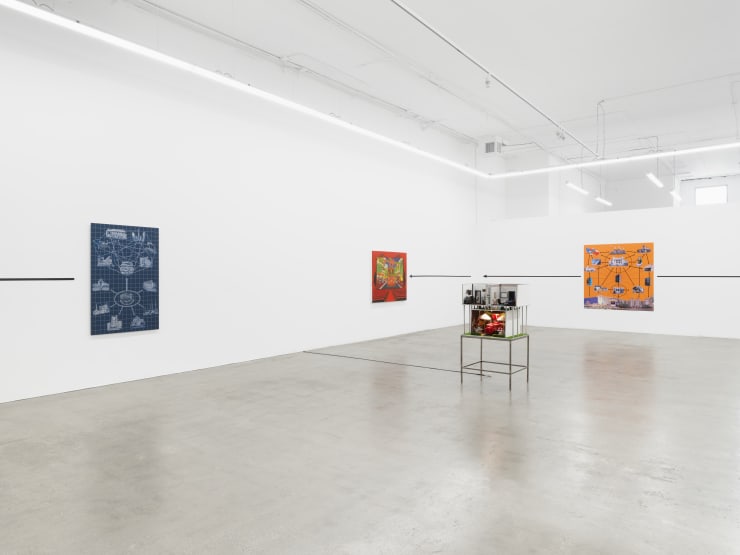Nick Angelo "La Pensée Unique"
Boom years and better places: herein lies a uniquely American doctrine made up of unfettered “development,” derivative architecture, and David Yurman stores, almost always pitching its tent under the marquee of the good old days. The French have a phrase for this. La pensée unique, coined by a French journalist in the ’90s, refers to any political dogma that smuggles itself into public favor under the guise of common sense. The chief example: Margaret Thatcher’s oft-repeated maxim “There is no alternative”—or “TINA”—made to portray the neoliberal free market as the world’s only sensible solution.
The expression is a fitting title for Nick Angelo’s sophomore exhibition with Sebastian Gladstone, expanding the artist’s practice of peeling these exact kinds of precepts apart. Across new paintings, wall graphics, and a two-story miniature diorama sculpture, La Pensée Unique collates many of Angelo’s familiar motifs with renewed vigor. Assembling matrices of crooked rhetoric, sugar-pilled state violence, corporate greenwashing, prisons, precincts, public schools, public sculpture, startups, suburbs, malls, methadone clinics, private gyms, and a scene from Andrei Tarkovsky’s Solaris (1972)—to name a mere few—the exhibition forges connections but avoids easy conclusions, refusing any temptation to tack on a dogma of its own.
Angelo’s style of thinking and making is rhizomatic by nature; try to forge a continuous path and you’ll surely get lost. This is, of course, by design. But in Le Pensée Unique, the Grove is a subtle throughline, winding through the various media like the outdoor mall’s single-track trolley. In TINA Caruso (2024), a painting of a luxe, velvet-curtained movie theater, Angelo supplants the screen at center with a rendering of the Grove’s main thoroughfare at Christmastime. The bedecked trolley car faces the empty seats head-on, as if about to barrel into the fourth wall. It smacks of the Lumière brothers’ 1896 film The Arrival of a Train at La Ciotat Station, whose footage of a fast-approaching steam locomotive had audience members fleeing for the exits. The same scene becomes even more real in his sculpture A Celebration of the Union of Dr. Kris Kelvin and TINA Caruso, One for the Ages (2024), restaged as a miniature diorama. Angelo sourced the tiny trolley, patio furnishings, fake foliage, and holiday decor from model-train and dollhouse stores, fashioning a toy garden city of a toy garden city.
What, then, to make of My God, Does He Eat Alone! (After Floris Claesz van Dijck) (2024), a master copy of the Dutch painter’s 1613 composition Still Life with Fruit, Nuts and Cheese? Most of Angelo’s references and reproductions skew more contemporary, urban, architectural, structural. But here is a recreation of a classic breakfast tableau painting, a rather popular convention in the early seventeenth century, a time that spurred the “emancipation of painting as a ‘liberal art.’” Floris Claesz van Dijck painted during the rapid urbanization of Dutch society; trade was booming and introduced the bourgeoisie to new, rare delicacies and products. Social-climbing patrons strayed from overtly Christian scenes, instead craving bountiful “expression[s] of a certain ostentation.”3 Angelo’s studious attention to the luscious colors and textures of the painting’s cheeses, grapes, apples, breads, nuts, glassware, and tablecloths seem to double the fetish impulse of the original. Through his gaze we can glimpse the Dutch Golden Age, the dawn of global capitalism, and the specter of colonialism, before we knew their horrors. In the context of La Pensée Unique, the work points to that era’s prelapsarian optimism, and the people’s belief that they were on the path to a better place and time.
—Juliana Halpert
1. Joan Didion, “On the Mall,” in The White Album (New York, NY: Simon and Schuster, 1979), 180.
2. Matt Tyrnauer, “Main Street of Dreams,” Vanity Fair, March 2013, https://archive.vanityfair.com/issue/20130301.
3. Hans Vlieghe, “Still-Life Painting, Animals and Hunting Figures,” in Flemish Art and Architecture, 1585–1700 (New Haven, CT: Yale University Press, 1998), 7.











